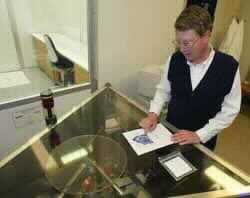Experts at the U.N. nuclear agency's laboratory on Monday received the first samples gathered by weapons inspectors in Iraq and planned to begin analyzing the material immediately. Eight samples were brought to the lab outside Vienna for screening, and another 20 samples were expected by the weekend, International Atomic Energy Agency spokesman Mark Gwozdecky told The Associated Press.
Gwozdecky would not elaborate on where in Iraq the samples were taken or say if the initial materials were air, soil, dust or water samples. The IAEA's lab in Seibersdorf, about 40 miles east of Vienna, will screen such materials for signs of unusual radioactivity.
Using electron microscopes, gamma and thermal ionization spectrometers and other tools, scientists at the lab say they will be able to find evidence - if any exists - that Saddam Hussein has a clandestine nuclear weapons program.
An initial analysis will take two to three weeks, and the findings will be brought to IAEA headquarters in Vienna for interpretation, Gwozdecky said. He said the samples that arrived Monday "are going to take priority" at the lab, which screens suspect materials from around the world.
The IAEA has said it hopes to have results from the screening of the first two dozen or so samples by the time agency director Mohamed ElBaradei reports back to the U.N. Security Council on Jan. 27.
The nuclear agency is heading the hunt for nuclear weapons in Iraq and the long-range ballistic missiles capable of delivering warheads to distant targets. A separate team of the New York-based U.N. Monitoring, Verification and Inspection Commission is searching for biological and chemical agents.
IAEA technicians screening the samples will look for radiation that exceeds the levels normally found in nature.
Using gamma spectrometers, the lab will be able to distinguish between recent releases of radiation and residue from the distant past, as well as tell the difference between isotopes used for medical applications and those of higher quality and intensity that a nuclear program would require.
If the lab gets a "hit" - evidence of an unusual amount of radioactivity - duplicate samples will be sent to sister labs in the United States, Britain, Russia, France, Germany, Japan or Australia for verification.
Among the U.N. inspectors' most important tools are 4-square-inch cotton swabs, which are being used to swipe the sides of suspect buildings in Iraq.
The swabs will collect minute particles of dust, and by analyzing the material, U.N. scientists will be able to detect uranium or plutonium down to a trillionth of a gram, making it impossible to conceal an active nuclear program, the IAEA says.
Scientists at the agency's lab also will screen air filters mounted atop key buildings in Iraq as well as samples of soil and water gathered by inspectors.
PHOTO CAPTION
David Donohue, head of the U.N. International Atomic Energy Agency's Clean Laboratory Unit in Seibersdorf, Austria, demonstrates the lab's tripod, a triangular aluminum-cased unit used to analyze the composition of a sample swab for traces of nuclear material November 28, 2002. Donohue said technicians and scientists would make sure they deliver results to the U.N. Security Council inside the two-month deadline. Photo by Leonhard Foeger/Reuters
- Author:
& News Agencies - Section:
WORLD HEADLINES


 Home
Home Discover Islam
Discover Islam Quran Recitations
Quran Recitations Lectures
Lectures
 Fatwa
Fatwa Articles
Articles Fiqh
Fiqh E-Books
E-Books Boys & Girls
Boys & Girls  Women
Women










